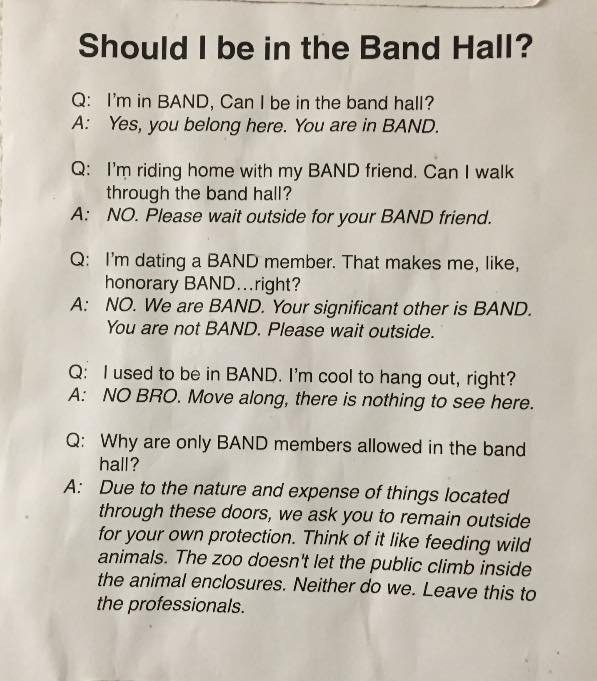Monday, April 2, 2018
 Your beginning tubas can be successful if you approach them with the same attention to detail that you do for all of your other beginning instruments! Here are some considerations that I use when starting tubas:
Your beginning tubas can be successful if you approach them with the same attention to detail that you do for all of your other beginning instruments! Here are some considerations that I use when starting tubas:
Picking the Players
Pick beginning players who show a good general sense of steady tempo and can loosely buzz their lips. To "free-buzz", I ask the student to flap their lips like a horse. Students are then given the mouthpiece: two fingers/thumb to hold it, with the pinky covering half of the end to give it some resistance. After a few low buzzes on the mouthpiece using a large volume of air, students try the instrument and attempt to play 3 open pitches (Below the bass clef staff Bb, low F, and second line Bb). I generally only recommend tuba for students that can play the low Bb from the beginning.
Transfers
If you have a student that is VERY enthusiastic about tuba, but is small in stature (5th grade), you can have them begin on euphonium but using the tuba method book so the transfer to tuba is easy after a year or so. If you are transferring an older student to tuba, and the sousaphone is the first instrument that they will play, watch the mouthpiece angle very closely. The neck and bits of a sousaphone can let the rookie player start with an unacceptable embouchure if a student is not already used to a proper angle.
Instruments
I recommend three-quarter sized tubas up to seventh grade and into 8th grade for most players. For advanced 8th graders and all high school players, a full-size 4-valved instrument is recommended. Common instrument problems involve dents/leaks in lead pipes and stuck tuning slides. Yamaha and Jupiter piston valve instruments have plastic valve guides that must be positioned properly. Rotary tubas must have tight linkages and arm bumpers in place. Valve alignment for pistons or rotary valves should be checked for proper port alignment during their stroke.
Mouthpieces
I have students use a Conn Helleberg 120S mouthpiece. The funnel shape helps promote a dark tone and the sharp inner rim leads to clean articulation. If you are a brass player, you may be surprised by the flatness of the rim. Many Bach style mouthpiece rims are overly wide and rounded, which can reduce flexibility and create vague articulations for some.
Playing
Find a balance point with the instrument. I have most beginners rest the tuba on the corner of the chair. If using the chair is just a bit too low, students can place a hockey puck or similar object under the bottom bow to raise the instrument slightly. If the student is tall for their age, they can hold it using their legs/thighs. A square of rubber shelf liner can be placed on the thigh or chair to reduce slipping. Just like any brass instrument, a slight downward angle on the mouthpiece is required. As with any wind instrument, focusing on tone from the beginning is key. Dropping the jaw using the "ping pong ball in the mouth" imagery, or keeping the teeth apart enough for their finger to fit between their molars can get the open sound we are looking for. I have had good results starting tuba players using "doo/doh/dah" articulations, as it keeps the tone open. Tubas in a full ensemble setting often require stronger articulations than their smaller instrument counterparts to provide clarity of rhythm (obviously not in ballads), so requesting a stronger "too/toh/tah" articulation helps in that clarity. The volume of immediate air needed to produce a strong marcato attack, especially in the low register, is very unique to tuba players. Air flow and breathing exercises are critical to achieve a full tone. Effective breathing will also lead to the full volume directors want to hear from their tuba sections. Require the same amount of musicality out of your tuba players as you would your other brass players, with the exception that tuba playing requires more spots to breathe.
Don't forget to get those tubas involved in solo and small ensemble festival just like your other students!
| Blake Duren is in his 11th year of teaching at Cameron R-1. Teaching responsibilities include brass/percussion instruction grades 6-8, the high school 7:02 Jazz Band, and co-directing the Marching Dragons and Symphonic Band. He studied tuba with Dr. Angelo Manzo at the University of Missouri-Columbia while he received his BSED in Music Education. His Masters in Educational Leadership comes from Northwest Missouri State University. Mr. Duren is a National Board Certified Teacher in Secondary Instrumental Music, was selected as a finalist for Northwest Regional Teacher of the Year in 2017, and is an All-State Band Tuba Judge. Affiliations include NAfME, NWMMEA, MBA, and the Cameron Municipal Band. |

